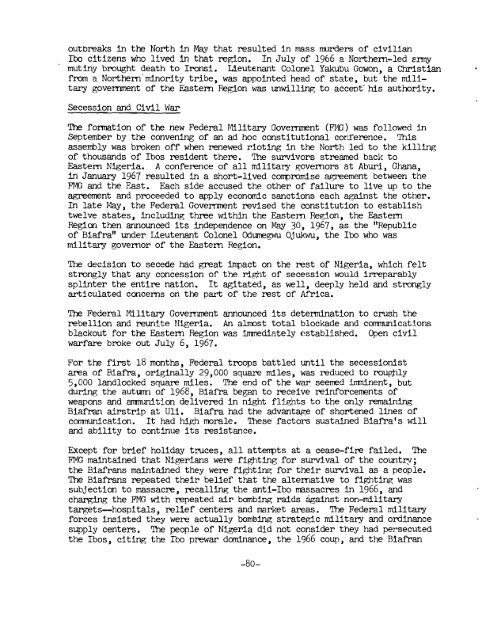3. - usaid
3. - usaid
3. - usaid
Create successful ePaper yourself
Turn your PDF publications into a flip-book with our unique Google optimized e-Paper software.
outbreaks in the North in May that resulted in mass murders of civilian<br />
Ibo citizens who lived in that region. In July of 1966 a Northern-led srmy<br />
mutiny brought death to Ironsi. Ueutenant Colonel Yakubu Gowon, a Christian<br />
from a Northern'minority tribe, was appointed head of state, but the military<br />
govemnt of the Eastern Region was unwilling to acce~t'his authority.<br />
Secession and Civil W a r<br />
The formation of the new Federal Military Government (FJG) was followed in<br />
September by the convening of an ad hoc constitutional conference. This<br />
assembly was broken off when renewed rioting in the North led to the killing<br />
of thousands of Ibos resident there. The survivors streamed back to<br />
Eastern Nigeria. A conference of all military qovernors at Aburi, Ghana,<br />
in January 1967 resulted in a short-lived compromise agreement between the<br />
FT\G and the East. Each side accused the other of failure to live up to the<br />
agmernent and proceeded to apply economic sanctions each against the other.<br />
In late May, the Federal Govemnt revised the constitution to establish<br />
twelve states, including three within the Eastern Region, the Eastern<br />
Regicn then announced its independence on May 30, 1967, as the "Republic<br />
of Biafra" under Lieutenant Colonel Cdumegwu Ojukwu, the Ibo who was<br />
military governor of the Eastern Region.<br />
The decision to secede had great impact on the rest of Nigeria, which felt<br />
strongly that any concession of the right of secession would irreparably<br />
splinter the entire nation. It agitated, as well, deeply held and strongly<br />
articulated cancerns on the part of the rest of Africa.<br />
The Federal Plilitary Government announced its determination to crush the<br />
rebellion and reunite Nigeria. An almost total blockade and c~icatlons<br />
blackout for the Eastern Region was mediately established. Open civil<br />
warfare broke out July 6, 1967.<br />
For the first 18 months, Federal troops battled until the secessionist<br />
area of Biafra, originally 29,000 square miles, was reduced to rou@ly<br />
5,000 landlocked square miles. The end of the war seemed imninent, but<br />
during the autumn of 1966, Biafra began to receive reinforcements of<br />
weapons and amnunition delivered in night flights to the only remalninff<br />
Biafran airstrip at Uli. Biafra had the advantage of shortened lines of<br />
comnunication. It had high morale. These factors sustc.ilned Biafrats will<br />
and ability to continue its resistance,<br />
Except for brief holiday truces, all attempts at a cease-fire failed. The<br />
FMG maintained that Nigerians were fighting for survival of the county;<br />
the Biafrans maintained they were fighting for their survival as a people.<br />
The Biafrans repeated their belief that the alternative to fighting was<br />
subjection to massacre, recalling the anti-Ibo massacres in 1966, and<br />
charging the FTE with repeated air bombing raids eainst non-military<br />
targets-hospitals, relief centers and market areas. The Federal military<br />
forces insisted they were actually bombing strategic military and ordinance<br />
supply centers. The people of Nigeria did not consider they had persecuted<br />
the Ibos, citing the Ibo prewar dominance, the 1966 coup, and the Biafran
















